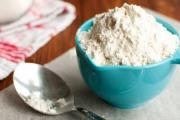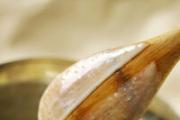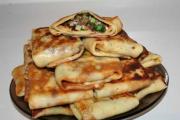Manti sauce is the secret of the success of an oriental feast. How to eat manti according to etiquette What to eat with manti
A plump woman is walking along the street, a beggar approaches her:
- Madam, I haven't eaten anything for five days ...
- Eh, I would use your will !!!
Yes, I would also complain about the lack of will if they offered me tasty, juicy, hot manti!
Manty, mantu or buuz, poses are a traditional meat dish of the peoples of Central and Central Asia, Turkey, Mongolia, Korea, Tatarstan, Bashkortostan and Crimea. The word manty, borrowed by the Russian language from the Turkic, comes, presumably, from the Chinese "mantou", "stuffed head", or, as a homonym, "head of a barbarian."
The last names, of course, are not entirely appetizing, and we will be closer to our native land, calling our dish "manty" as our parents and grandparents called them.
Before we start making manti, we will choose what kind of manti we will cook. There are many options, from form to content. From size to preparation method.
For example:
Kava manta
Kava is a pumpkin that is used as a filling in equal proportions with lamb. Steamed. A variety of kava manta is khoshan, fried manti. Such manti are first fried in vegetable oil until they reach a golden crust, and then they are placed in a manti cooker until cooked. This method of cooking allows you to get rid of the harmful substances formed during frying, and at the same time leaves the taste of the fried product.
Jusai-manta
Steamed. The Jusai plant is used as a filling. This is such a branchy sweet onion, a perennial herb of the Onion family, which possesses all the properties of onions and garlic. Leaves with a unique onion-garlic taste are used for food. All parts of the plant are edible.
Can be used with lamb or alone.
Baldurgan manta
Steamed. This dish uses yeast dough. Manty turns out to be "lush", that is, "boldurgan". Either only meat (lamb) or meat together with dzhusai is used as a filling. And yet, they say that such a yeast dough is prepared in winter.
So, we will assume that we have made our choice and our relatives, our beloved ordinary Uzbek manti, will flaunt and eat with pleasure on our table today.
Let's start with the filling.

Most often, minced meat is prepared from lamb, but options from a mixture of different types of meat are possible. Various options with a mixture of pumpkin and meat are popular; vegetarian - from pumpkin, potatoes, mushrooms.
Instead of pumpkin, carrots or other vegetables can be used that, when boiled, can give a little juice for juiciness and tenderness of the meat. In the coastal regions of China, even shrimp is used as the main component of minced meat. Some people use pork, camel meat, goat meat, and poultry in minced meat. Who likes what or who is used to what.
The most important point in preparing manti filling is not to use a meat grinder or blender. Only a sharply sharpened knife and hands can cut meat with high quality, at the same time removing everything unsuitable for manti. But keep in mind - these trimmings are great stock material! Better not to throw anything away.
The meat is finely chopped with a knife into cubes, fat and onions are also cut, which is taken in a 1: 2 ratio. The more onions, the juicier the filling will be. The main spice for manti is cumin, salt and black pepper, we cannot do without them. The rest of the spices - cumin, red pepper, garlic, marjoram, coriander and basil are added to taste, making the minced meat somehow especially tasty and aromatic.
We begin to cut the meat into strips and chop into squares. Minced meat in manti should be crumbly, so it is chopped with a knife, and not with kitchen hatchets. A meat grinder or food processor will not work because they both knead the meat and make the mince stickier. Chop the fat tail fat with a knife into 0.5 cm pieces. Cut the onion into thin half rings. It can be fried for a variety of flavors. For traditional manti, a lot of onions are cut - it is the onion and lard that should form that delicious broth in the manti, and only thinly chopped onions release juice during heating.
Mix onion, meat and bacon. The filling of the manti should be juicy. In order for the onion to give juice, the minced meat must be kneaded by hand. If you don't want your hand to smell, wear a thin rubber glove. Squeeze the minced meat a little to remove excess air and the meat and onions fit snugly together. Leave the filling to marinate for 30 minutes.
Now let's make the dough.


Unleavened dough for manti is made from water, salt and flour, sometimes with the addition of eggs. To obtain a soft and elastic dough that does not break, even if it is rolled out too thinly, water and flour are taken in proportions of 1: 2. For 500 g of flour, 1 egg is enough, and if you want the dough to be especially tender, you can replace the water with milk. Some housewives first bring the milk to a boil, and then add it to the dough, since the choux pastry keeps liquid inside the manti well during the cooking process.
We mix salt and water. You can add yolks. Knead the dough well and make a ball out of it. We wrap it in plastic and set it to “rest” for 30–40 minutes. If the room is hot, it is best to put it in the refrigerator. If the temperature is medium, leave it on the table.
Cut the settled dough ball in half and roll one half into a circle with a layer of 1-2 mm. Wrap the remaining dough in foil and set aside. Ideally, the dough should be so thin that the filling is visible, since the art of making manti is judged primarily by the thickness of the dough. It is important not to overdo it, otherwise the dough will break. We cut it into squares from 10 to 15 cm. Put 1 tablespoon of the filling in the middle of each square. We connect the sharp corners on opposite sides of the square cake from above, and pinch the new corners formed at the bottom with each other on the sides. The adjacent corners of the quadrangular asterisk stick together in pairs, forming ears.
Some housewives form bundles of dough, cut into pieces, roll each piece into a ball and roll it thinly with a rolling pin. The diameter of the resulting pancake should be at least 10 cm. Put the filling in the middle, lift the dough circle by the edges from opposite sides and connect, in the same way do with the other edges of the pancake. Pinch the corners diagonally, and the manti are ready. In Asian cuisine, another method of sculpting manti is used - the filling is placed in the middle of the pancake, then the dough is raised from three sides and beautifully connected.
There are many forms of manti - choose the ones that seem to you the most simple and cute. Before cooking, the manti is sometimes left for 10 minutes, covered with a towel, and only then they begin to cook.




Manty, as we know, is not boiled in water like dumplings. They are cooked only for steam, and most often a specialized kitchen utensil is used for this purpose. It consists of two pots with a lid, stacked on top of each other. Water is poured into the lower pot, and the bottom of the upper pot resembles a colander through which steam penetrates.
Before starting cooking, it is necessary to grease the sheets from the mantle with melted butter, or you can grease the bottoms of the mantas themselves or simply dip them in it. We put the manti on the sheets of the mantle cooker, but not too close to each other.
They do the same with frozen manti, and you do not need to defrost them before cooking. The boiling process usually takes about 40-50 minutes.
While our mantis are boiled and steamed, we can set the table with various pickles, prepare salads and sauces, which are certainly important attributes when serving.
Appetizing manti are poured with melted butter before serving, sprinkled with black pepper and allspice. This dish is served with sour cream, mayonnaise, horseradish, mustard, spicy tomato or yogurt sauce, vegetable salad or meat broth. A popular seasoning is sour milk (katyk) or fried onions, black and red peppers. In addition, mint, basil and other seasonings are added.
Uyghur manti are eaten with lasjan, a spice of red pepper seasoned with vegetable oil. Also popular is "cobra" - a seasoning of tomatoes, hot peppers and garlic.
Manti is best eaten hot, enjoying their bright oriental taste and aroma. This is a real delight for lovers of Asian food. But like the dumplings, the remaining cooked, we can heat up or fry the manti in a pan with butter the next day until golden brown. Believe me, this is very, very tasty.
Of course, manti is one of the most delicious and favorite types of food in Uzbekistan. Manty is not just a tradition. Manty is a feast, it is a great pastime among family and friends. This is a great opportunity to prepare for future use before receiving any guests, including unexpected ones. This dish can be a wonderful hot treat for any festive table.
Bon Appetit!

BELA FELDMAN
Everyone who sees these envelopes with filling for the first time has a question: how to eat manti? Meanwhile, it is not difficult to suck. Moreover, the right choice of sauce can make this oriental dish even more delicious.
What are manti?
Manty or mantu is a traditional dish for almost all Turkic peoples. The word "manti" is borrowed from Chinese and means "stuffed head". True, each region has its own name, as well as traditions of preparation and consumption of this dish. But this is certainly a steamed envelope made of thin dough with a juicy filling.
Like most dishes of oriental cuisine, manti is more convenient and correct to eat with your hands. This is the only way to save all the juice that the filling gives off. By the way, the rules of eastern good form stipulate that you will not eat the corners of the dough, for which the mantas were held. Manti is served hot and on a large platter with lots of greens (parsley, cilantro, basil). Greens help break down and absorb fatty foods. An oriental appetizer such as pickled onions will be a good addition to mantas. It is very simple to prepare it: the onion is cut into rings and soaked in a marinade of water, vinegar and sugar. After such a procedure, excess bitterness leaves the onion. With this onion, manti is abundantly sprinkled on a platter or served separately.
Sour cream (in pure form or with finely chopped herbs) and various tomato sauces (sweet, sour, bitter, but always with a lot of oriental spices) are served with mantas. A sauce made from fresh tomatoes is considered a classic: tomatoes are passed through a grater, hot peppers, garlic and a lot of greens are added to them. By the way, if sour cream is too fat for you, you can replace it with kefir or yogurt.
Another interesting sauce can be made on the basis of strong meat broth. There you need to add a little butter, herbs, ground black pepper. Some people think that a little vinegar should be added to this sauce, but this is purely a matter of taste.
In general, connoisseurs of the real taste of this dish assure that no sauces are needed for manta rays. You need to take them by the tail, bite and enjoy your own juice of the filling, or, in extreme cases, dip mantas in melted butter.
What are the manti stuffed with
The classic filling for manti is minced meat with the addition of a large amount of onions. Of course, like most oriental dishes, lamb or nutria meat is used for minced meat. In our conditions, the use of pork, beef and even chicken is allowed. The main condition is that the minced meat should not be too dry, so it is worth adding more fat to it. Best of all, if it is lamb fat. There is also one little secret - for juiciness, grated or finely chopped pumpkin is added to the minced meat. By the way, manti can be generally lean; you can use potatoes, cabbage or a mixture of any ingredients as a filling. Of course, minced meat for this dish cannot be imagined without spices and fresh herbs.
Gourmets know the unique taste of real manti. Their smell fills the entire body and causes an uncontrolled flow of hungry saliva. And when there is no more strength to endure, after a long 45 minutes, a whole dish of steaming manti is finally put on the table, the feast begins.
Manty is a real feast for the stomach! Believe me, those who have tasted this dish at least once will forever remain in the ranks of its ardent admirers and loyal admirers.
In the cuisine of all countries of Asia and the East, there are manti, only this dish is called differently everywhere. The origin story, as always, has no historical confirmation and looks more like a legend. It is absolutely certain that manty comes from China.
Historians of the Celestial Empire say that this dish got its name after a certain Chinese commander could not overcome a small, but very turbulent river. Liang Juge was advised to pay for the crossing by making a sacrifice. The water spirit needed fifty barbarian heads. So the priests said, and it is not accepted to argue with them.
Having shown ingenuity, the cunning Chinese man deceived both the priests and the spirits. He ordered to steam meat pies and mold them so that they resemble a human head. Liang Juge called them "manty" or "mantou", which in one translation means "head of a barbarian", and in another - "stuffed head". The trick succeeded, and the name stuck to the dish.
How the mantas were called before is no longer understandable. Perhaps one of the surviving names was the first. The Uyghurs call them buuz, in the countries of Central Asia they say poses or bozes. In many parts of China, manti also have different names. Most often they are called mantou or bangzi. The most interesting thing is that not only the names do not coincide, but also the recipe of this dish. And still they say that manti is cooked.
The dough for making classic manti is kneaded with water and flour, salt is added. Eggs are not put in such a dough. Therefore, the statement that for manti the dough is kneaded like dumplings is fundamentally wrong. The dough structure of these products should be different. And the elasticity, which is so necessary for making dumplings, is completely unsuitable for manti. As a last resort, you can put only the yolk. The protein will make the dough "rubbery". The dough should lie down for at least two hours. During this time, it must be kneaded several times.
It will take an hour to prepare a real filling. Meat in manti is the most tender lamb. It should be fresh, not frozen. Finely chop both meat and onions. In order for the manti to be juicy, the volume of the onion should be two-thirds of the amount of meat. All this is cut into small cubes. Then add salt, pepper, be sure to add cumin, rubbed with your fingers.
A small but very important secret. If you add a little milk or water to the minced meat, then the manti will be unusually juicy. Try to do this once, and very soon the manti will not seem juicy without this addition.
Let the minced meat stand for about twenty minutes, so that the smell of onion and cumin saturates the meat. Now roll out the dough very thinly. Manti is molded in each country in its own way. Somewhere crosswise, somewhere they leave a hole, and here and there, according to ancient tradition, they still depict the head. Choose how to sculpt yourself, this does not affect the taste.
Cook them in mantis. This is a special form of a saucepan with several tiers. They have flat, perforated aluminum plates. Water boils in the lower part, steam flows evenly through the holes. Due to this, manti is cooked.
Achik-chuchuk salad is prepared for manti. It is thinly sliced onion and tomatoes. They are salted, pepper, finely chopped basil leaf is added and decorated with pomegranate seeds. You can put sour cream or cream on the table. Just never serve mayonnaise with manti. With his weight, he will simply kill the unique subtle taste of this dish.
By the way, the word "manty" is not singular. You should say: "Manty, one piece." The inventive Russian language added the suffix "-yshk" to the incomprehensible and not very convenient word to use, and the result was a delicious mantyshka.
The filling of manti can be different. Mixing mutton, beef, and pork (which is what the Chinese do) will give consumers a real culinary shock. Manti with potatoes are very tasty. You just need to put in each small piece of butter, otherwise it will be dry.
Manty is cooked with chicken and pumpkin. Sometimes all of these ingredients are mixed. Meat, potatoes and pumpkin are delicious! Manti made from yeast dough have a very interesting taste. So manti is a field for the implementation of the creative ideas of every housewife!
One of the most famous Asian dishes in the world is manti. There are many recipes for their preparation. More precisely, the principle of preparation is the same, but there are a lot of small deviations and varieties of fillings, as well as options for what to serve manti with. Being prominent representatives of the cuisines of many countries and nationalities, they acquire a national flavor most often thanks to the sauces with which they are served.
Indeed, how else? The dough for manti is the most common, as for dumplings. Most often meat is used as a filling: pork, beef, lamb, but sometimes fish, vegetables and various mixtures of ingredients. Of course, various seasonings, onions and spices are also present in the dish. The stuffing products are not chopped in a meat grinder, but finely chopped with a knife. Manti themselves, unlike dumplings, are not boiled in water, but steamed. By the way, this is where their name came from. There is a Chinese word for “mantiou” (馒头), which translates as “steamed bread”. After all, the manti themselves, according to legend, were invented in China. True, over the years of travel of the recipe, it has changed in the cuisines of various nations, and now "steamed bread" can be found both fried and boiled in broth. What are manti served with? This is also individual in every kitchen.
What can be served with manta rays?
Please note that more often manti, unlike dumplings and other similar dishes, are eaten without using appliances, with their hands. Sauces and spices are usually not poured per serving, but served in a separate bowl. Manty is dipped in a saucepan before use. You can put the sauce inside, slightly biting the dough. Manti is often prepared without splitting them on top. During the cooking process, a filling in aromatic juice forms inside the dough. The sauce is placed with a small spoon in the hole in the dough, making the filling even more flavorful. This allows you to use different sauces while experimenting with flavor.
Of course, the complexity of the manti sauce will depend on the situation. If you have a semi-finished dish prepared in your refrigerator, and you decide to eat it for no reason, just at lunch or as dinner, then it is quite acceptable to get regular ketchup or some other ready-made sauce for them.
Simple and quick sauces
Of course, ketchup is the first thing that comes to mind. You can think of a lot of examples of such simple and affordable additions to manta rays:
Butter.
Ready-made ketchup can be replaced with mashed tomato.
A mixture of sour cream with ketchup or ketchup with mayonnaise.
Soy sauce.
Other prepared sauces, hot or sour.
Such examples can be enumerated for a very long time. All of them are tasty and loved in their own way. But if you decide to cook manti as a festive dish, if you want to feel all the charm of manti cooked with your own hands and enjoy the dish to the fullest, use one of the more complex serving, choosing a sauce according to your mood and situation.
Popular sauce for manti santan
Santan is what manti and meat are often served with, flavored vegetable oil. This sauce is often called Almaty sauce. They are usually watered with manti when served. It is easy to do, but it takes some time.
To prepare santana, take:
150 grams of vegetable oil. Refined, odorless is more suitable. The added spices will give it a flavor.
Prepare garlic - 8 cloves.
Tomato paste - 1 tablespoon.
Hot red pepper, finely chopped or coarsely ground - 1 tablespoon.
The preparation of the sauce must be started at least an hour before the planned serving of the dish.
Heat the prepared red pepper in a pan without oil, fry it a little, controlling the process, until a bright aroma appears.
In a bowl, stir the cooked pepper, tomato paste and chopped garlic.
Heat the oil well in a frying pan and pour into a bowl with the prepared aromatic mixture.
Mix everything and leave to infuse for at least an hour. Ingredients that settle to the bottom will give the oil its color and aroma.
No less popular sauce is shakarap
Take a pound of tomatoes and cut them as small as possible.
Peel, chop and add two sweet onions (white ones are more suitable) and 3-4 cloves of garlic.
You will need meat broth - 200 grams. Pour it into the sauce.
Spices (pinch): red pepper, black pepper, cumin and a little salt. All this also needs to be added to the bowl with the sauce and mixed.
Leave to infuse for at least 30 minutes.
Tomato sauce for manti
Less "oriental" tomato sauce without specific spices:
The tomato can be grated on a coarse grater, so it will be possible to get a more uniform consistency of the sauce.
Grind a couple of tablespoons of herbs to taste. It can be dill or parsley that we are used to.
Add two cloves of crushed garlic, salt and stir in the prepared sauce.
Vinegar sauce
When choosing what to serve manti with, various vinegar mixtures occupy not the last place in popularity. Here is an example of a simple but delicious vinegar sauce that will add extraordinary flavor to the mantas when added inside through the bitten hole.
Dilute regular vinegar with water in a proportion that will allow it to be consumed.
Add some black pepper and paprika. The sauce with excellent aroma is ready.
Onion-vinegar
When choosing with what to serve manti on the table, pay attention to this option. Making the sauce is an elementary process. Chop the onion finely, add a little vinegar and marinate for 30 minutes or more. Before serving, dilute with a little boiled water.
Sour cream sauce
What other sauce is served with manta rays? Here's an example of the simplest sour cream sauce. Mix 100 grams of sour cream, two chopped garlic cloves and a spoonful of chopped dill.
how and what to eat manti properly? and got the best answer
Answer from Daria [active]
I think they eat them with their hands ... there is a lot of juice there ...
Answer from Mikhail Khokhlov[guru]
With adjika and vodka.
Answer from Vasily Boldakov[active]
Better mouth
Answer from Sweet Cherry *[guru]
With sour cream and a fork.
Answer from Max Pupyshev[newbie]
They eat with their hands. Take the pint from above. the pint (dough) itself is not eaten.
Answer from User deleted[active]
silently and by mouth
Answer from Pusik[guru]
generally eat with your hands
Answer from AI3[guru]
with your hands, take the sides with 2 fingers, bite off from above so that the fat does not drain anywhere
Answer from Old dog[guru]
With your hands. if you take into account whose cuisine it is, it immediately becomes clear. there is a tete of cutlery
Answer from Personal account deleted[guru]
at home with your hands. like pies .. and in catering establishments you have to tear with a fork ..
Answer from Yovetlana[guru]
Filling: 600 g of meat - beef, lamb, turkey thigh - shuarma (my favorite), you can add fat, fat tail - lamb lard. 3 large onions salt pepper 1/2 tsp. ground cumin 1/2 tsp ground coriander 2 tbsp. spoons rast. butter Dough: 1 glass of water (200ml) 1h. l. salt 1 tbsp. spoon rast. butter flour to knead the tough dough Method of preparation In a deep bowl, sift about 500 gr. flour and make a slide with a depression inside. Dilute 1 hour in a glass of warm, boiled water. l. salt. Pour a glass of salt water into a depression in the flour, then a spoonful of rast. butter and knead hard, tough dough, like dumplings. Cover the dough with a towel and leave it to rest, I let the dough sit for about two hours. At this time, I prepare the filling. Cooking the filling: Cut the meat (1 * 1 cm) and onion into cubes. Stir with all the seasonings, add rast. butter and mix well. For cooking manti, we need a special steam pan - a cascan, which consists of a saucepan, into which we pour water and pots, into which we will spread the manti for cooking. Pour boiling water from a kettle into the main pan, salt. Put the manti in saucepans greased with vegetable oil (so that the manti does not stick to the bottom). If you need to cook a large number of manti, then you can pour the rast. oil in a cup and dip each mantu in rast. oil (up to the middle of the manty height), lay out next to each other, then the mantas will not stick together. Cooking time - 50 minutes from the beginning of boiling water. At the end of cooking, turn off the gas and open the lid so that the steam leaves, so that the manti does not get wet. It is better not to lay out the manti immediately, but to let them stand for 10-15 minutes. They will not have time to cool down and they can be laid out without prejudice to their appearance, it is very important that the manti does not break and the tasty juice does not leak out. I serve tomato sauce with mantas: Grate tomatoes without skin (or chop in a blender), chop greens: dill, green onions. Squeeze the garlic in a garlic press. Add salt and pepper to taste. Can be acidified with vinegar. Each eater is served a cup of tomato sauce. We eat manti with our hands, bite off a piece, put tomato sauce inside and enjoy! ! Hot manti with cold sauce ... just a song ... a delight to taste ..
Answer from IVA[guru]
In Kazakhstan and Kyrgyzstan, they eat with their hands, but in general, as they like
Answer from Ekaterina Ivanova[newbie]
they are eaten as usual with a fork ... with pita bread or flat cakes ... you can taste with mayonnaise)))













